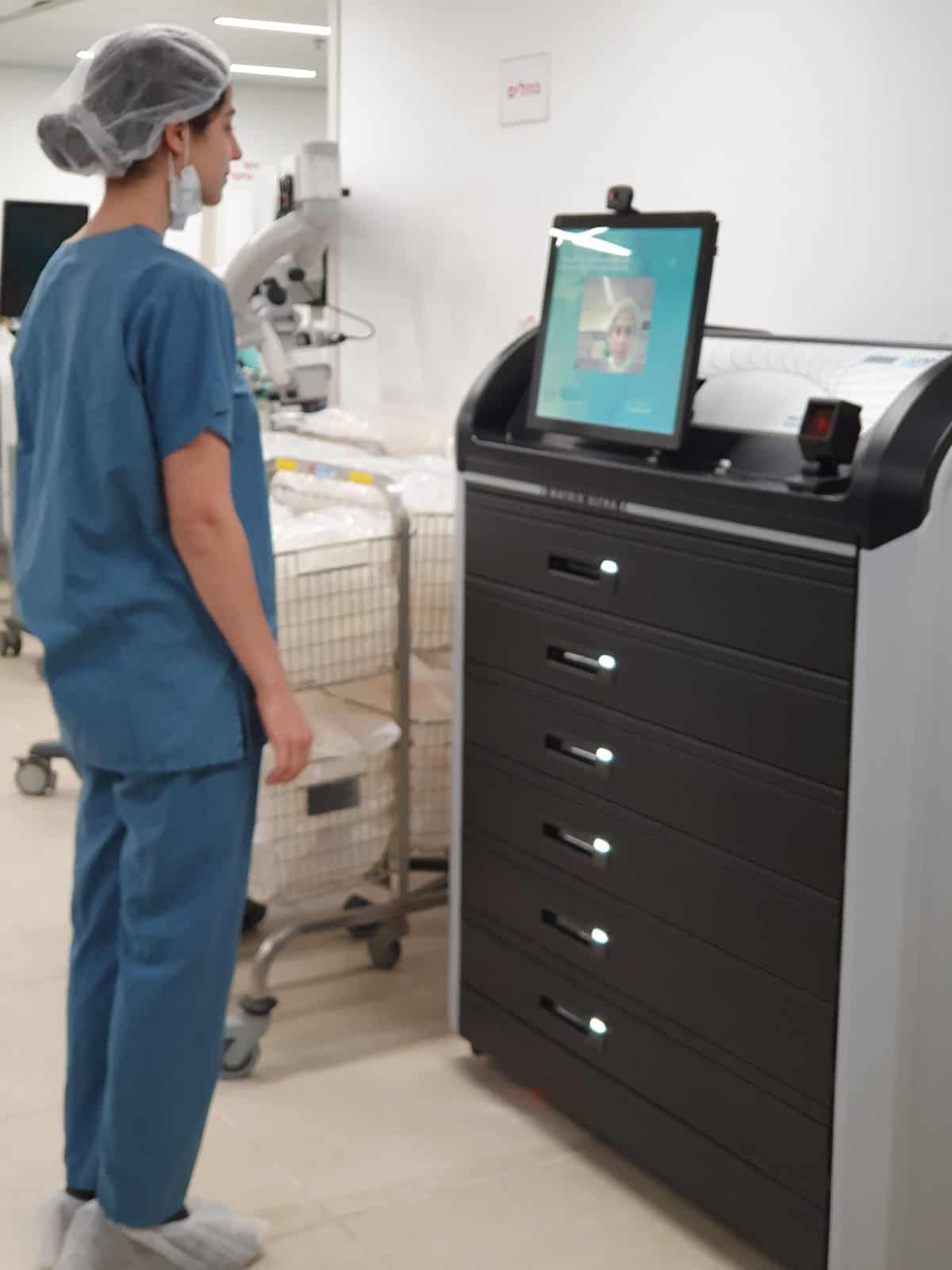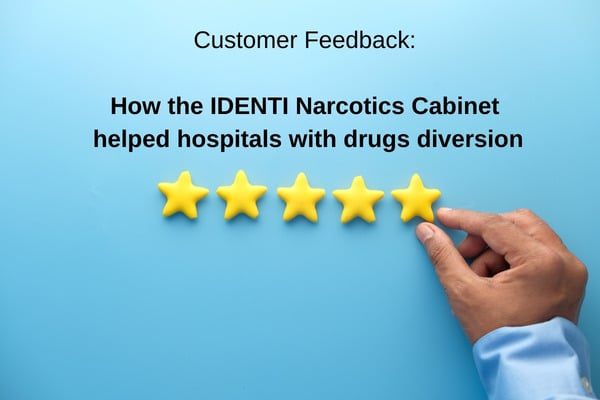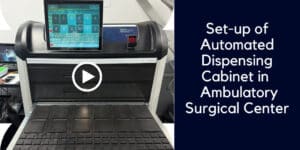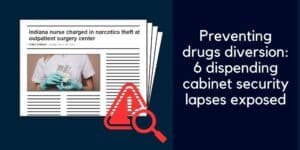What’s inside:
Drugs diversion in US hospitals is a constant issue, this ebook explores:
- What is drugs diversion in healthcare
- Drugs diversion stats in the US
- Drugs diversion management in hospitals
- Guidance on controlled substance diversion prevention programs
- Use of automated narcotic cabinets to prevent drugs diversion in healthcare
- How to select the best automated narcotic cabinet for drug diversion prevention
- Best practice for preventing drug diversion using technology
Fight Drug Diversion: Automated Dispensing Cabinets for Hospitals
Executive Summary:
This e-book looks at current issues and best practices in the fight against drug diversion in US hospitals and explores how automated narcotics cabinets can support drug diversion prevention programs.

- Drug diversion costs the US healthcare industry over $70 billion per year.
- Up to 10% of registered nurses may be dependent on drugs or alcohol.
- Approximately 15% of healthcare workers will struggle with drug dependence at some point in their careers, driving them towards drug diversion.
- Over 10 million people misuse opioids – there are 50,000+ deaths per year in the US
- A Joint Commission report from 2019 found that 10% of the hospitals surveyed did not meet medication security standards, including those meant to prevent diversion.
Drug Diversion is when prescription drugs intended for an authorized patient use are diverted, generally for financial gain or personal use. The drugs may be diverted by anyone with access to the medication or prescription.
Joint Commission:
“In every organization, drug diversion is a potential threat to patient safety. Risks to patients include:
- Inadequate pain relief
- Exposure to infectious diseases from contaminated needles and drugs
- Unsafe care due to the health care worker’s impaired performance.”
The American Society of Health-System Pharmacists (ASHP) says:
“Successful diversion prevention requires systematic attention….
It is imperative that organizations
establish a Controlled Substance Diversion Prevention Program (CSDPP)
that discourages diversion and strengthens accountability,
rapidly identifies suspected diversion incidents,
and continually seeks to improve controls”

The ASHP Controlled Substances Diversion Prevention Program has three levels:
Core
System
Provider
Each level details areas where preventative action can be embedded within hospital and ASC workflows in order to tackle drug diversion activities.
The ASHP is keen on the use of automated dispensing cabinets, advising:
“When available, automated solutions that support adequate control, surveillance,
and auditing processes should be implemented”.
These are the four things you need to ensure your systems and technology assist in the prevention of drug diversion:
- Use a reputable, secure and automated narcotics cabinet.
- Find a system that assures full accountability of all users.
- Ensure the known process weak points – wastage and returns – have robust workflows
- Use system reports and data analytics to identify usage and stock issues.
IDENTI Medical’s Narcotic Cabinet is a secure medication management solution that has been designed for use by clinicians in hospitals and surgical centers. It has a range of anti-drugs diversion features that give it the functional capability to play an effective role in any drug diversion prevention strategy.

Drug Diversion Prevention Features include:
+ Limited access using face-recognition or biometrics
+ Secure, locked drawers and cells
+ Single cell dispensing and returns
+ Wastage is recorded
+ Fully accountable dispensing by clinicians
+ Pharmacy managed and validated
+ Reports, metrics, data insights
Drug diversion occurs extensively in the healthcare sector, and improved systems and processes are needed to tackle it.
Our e-book details how to optimize the use of technology and streamline dispensing workflows in order to improve the rapid detection of drug diversion.
IDENTI’s Secure Narcotic Cabinet has built-in anti-drug diversion features, providing healthcare organizations with enhanced security of their controlled drugs and narcotics – even where dispensing is decentralized.
Introduction:
This e-book looks at the disturbing issue of drug diversion in American healthcare organizations.
With 10-15% of the US hospital workforce estimated to have substance abuse issues, drug diversion in hospitals is a constant battle for management.
Prescription medicines and controlled substances, such as opioids, are regularly rerouted from the intended patient by errant healthcare workers.
Looking across the whole population, the opioid crisis continues to rage across the US, with over 10 million people misusing opioids, and a shocking 50,000 deaths per year *2
Getting the right preventative measures in place is key, yet 10% of hospitals are estimated to operate with subpar security for the controlled substances they store and dispense.

Drug Diversion in Hospitals
Drug Diversion Stats at a Glance
- Drug diversion costs the US healthcare industry over $70 billion per year. PSQH*1
- Up to 10% of registered nurses may be dependent on drugs or alcohol. The American Nurses Association
- Approximately 15% of healthcare workers will struggle with drug dependence at some point in their careers, driving them towards drug diversion. National Council of State Boards of Nursing
A Joint Commission report from 2019*3 found that 10% of the hospitals surveyed
did not meet medication security standards,
including those meant to prevent diversion.
So, what can hospitals do to improve the security of controlled drugs and narcotics?
In this e-book we look at current issues and best practice in the fight against drug diversion in US hospitals. We then discuss the specific features to look for when selecting an automated narcotic cabinets that can support a hospital drug-diversion prevention program.
What is drug diversion in healthcare?
Drug Diversion is when prescription drugs intended for an authorized patient use are diverted, generally for financial gain or personal use. The drugs may be diverted by anyone with access to the medication or prescription.
Fentanyl has been cited as the drug that is most commonly diverted – it is a synthetic opioid which is fifty times stronger than morphine. According to US Immigrations and Customs Enforcement (ICE), in 2016 over 20,000 Americans were killed by fentanyl and fentanyl analogues, a number which continues to rise.
Methods of diverting controlled substances in hospitals include:
- Giving patients’ lower doses than prescribed – which may leave them with unrelieved pain
- Falsifying medication records
- Dispensing larger amounts than the patient requires
- Withdrawing controlled substances for a discharged or transferred patient
- Substituting controlled substances with other materials, such as saline
- Failing to waste or document waste such as partially used vials
It’s not always easy to identify staff who are diverting drugs. Preventing the misuse of controlled substances and narcotics is a legal and ethical responsibility. Healthcare organizations need to take a strong and public stance on this, making all staff aware that they will be held responsible and accountable for their actions and backing this up with tight systems and controls to record usage and check dispensing record data.
What are the dangers of drug diversion in hospitals?
Drug diversion is a significant liability risk to the hospital, one that can result in the criminal prosecution and loss of license of staff. It has an organizational impact on several fronts, including:
- Having a negative effect on the quality of patient care
- Costing hospitals billions of dollars a year across the US
- Highlighting weakness in the hospitals systems and procedures
- Increasing the availability of controlled substances in the public domain
- Contributing to drug misuse and addiction
- Decreased community confidence and loss of reputation
“In every organization, drug diversion is a potential threat to patient safety.
Risks to patients include inadequate pain relief and exposure
to infectious diseases from contaminated needles and drugs,
compounded by potentially unsafe care due to the
health care worker’s impaired performance.”
Joint Commission *3
Which areas of a hospital are most likely to be affected by drug diversion?
Operating Rooms and Emergency Departments are considered to be the two highest risk areas for drug diversion.
Anesthesia has been highlighted as the specialty most at risk from drug diversion activity.
It is thought that most drug diversion in hospital is to feed the personal habits of clinical staff rather than for personal gain.
Action taken against identified Drug Diverters by US Hospitals
In terms of the treatment of employees found to be diverting drugs, the stance of hospitals is starting to change.
It is recognized that hospital staff will mirror wider society, so will encompass a similar ratio of people with addiction issues. Many of these staff will have ready access to controlled drugs and become involved in diversion activities. These may be highly skilled staff with excellent records.
In 2017 IntNSA, the Emergency Nurses Association and the International Nurses Society on Addictions issued a position paper advocating an alternative to discipline (ATD) and this has had an impact on the disciplinary actions of many US healthcare organizations, who are now more likely to offer to help and support for their employees’ addictions as part of their drugs diversion prevention activities.

Drug Diversion Management in Hospitals
The American Nurses Association has highlighted the role of pharmaceutical and clinical staff in the security of controlled medication.
According to the ANA: Prescribers are the gatekeepers for prescription opioids.
“Although actions to address prescription opioid abuse must target all … prescribers are the gatekeepers for preventing inappropriate access.”. *4
The American Society of Health-System Pharmacists (ASHP) says:
“Successful diversion prevention requires systematic attention….
It is imperative that organizations establish a Controlled Substance Diversion Prevention Program (CSDPP) that discouraged diversion and strengthens accountability, rapidly identifies suspected diversion incidents, and continually seeks to improve controls” *5
Let’s look into CSDPPs in a bit more detail, as this provides a framework for hospitals and surgery centers to use to set up or review their own local programs.
Guidance on Controlled Substance Diversion Prevention Programs
The Joint Commission is urging hospitals to improve the systems and procedures they have in place to keep controlled substances safe.
They endorse the American Society of Health-System Pharmacists (ASHP) ‘Controlled Substances Diversion Prevention Guidelines’*5 – which has three levels:
- Core Admin
- System Level
- Provider Level

The ASHP – Essential Components of a Substances Diversion Prevention Program has three Key Areas:
Core Administrative Elements:
- Legal and regulatory requirements
- Organizational oversight and accountability
System Level Controls:
- Human Resource management
- Automation and technology
- Monitoring and surveillance
- Investigation and reporting
Provider Level Controls:
- Chain of custody
- Storage and security
- Internal pharmacy controls
- Prescribing and administration
- Returns, waste and disposal
Core Administrative Elements
All systems and procedures in hospitals need to provide regulatory and legal compliance as a minimum. Some automated narcotics cabinets have weak points that leave hospitals open to non-compliant activities.
Organizational oversight and accountability are achieved by capturing full staff dispensing activity. A system that provides full accountability and backs this up with helpful data reports will prove to be an invaluable tool for hospital management.
System Level Controls
The System Level element includes:
- Human Resources Management
- Automation and technology
- Monitoring and surveillance
- Investigation and reporting
The ASHP lists four elements of system controls for hospitals and ambulatory surgery centers. In reality though it is the automation and technology that support the other three criteria.
Automation provides data reports and insights that support the monitoring and surveillance of staff and inform the Human Resources Department, as well as underpin the investigation of suspicious activity.
The ASHP advises:
“When available, automated solutions that support adequate control, surveillance, and auditing processes should be implemented”.
Getting the technology right by investing in healthcare automation solutions that are fit for purpose, is the key element to any drugs diversion prevention program.
Provider Level Controls
The ASHP cites five key elements to improve security and prevent diversion at the provider level:
- Chain of custody
- Storage and security
- Internal pharmacy controls
- Prescribing and administration
- Returns, waste and disposal
Let’s take a closer look at these and identify the systems and procedures that can be put in place to provide more robust workflows and greater security.
Drug Diversion Prevention Program – Chain of Custody
The Chain of Custody is like a drugs data trail and has become a legal obligation for healthcare providers. Hospitals need to ensure that the supply chain of drugs from procurement, storage, proscribing, administration and wastage or return is dealt with securely and compliantly.
Hospital systems need to provide secure storage, perpetual monitoring and effective tracking of controlled substances, as well as the personal accountability of all healthcare staff handling these drugs.
The ASHP advice: “When using an automated dispensing device for dispensing and storage of CS, transactions should be tracked and reconciled electronically”. This supports the digital recording of the chain of custody at the point of dispensing.
System reports should also be able to identify gaps in the chain of custody throughout the medication management workflow.
Drug Diversion Prevention Program – Storage and Security
All medicine cabinets storing controlled drugs need to have security that limits entry to authorized staff only.
According to ASHP guidelines internal process need to ensure:
- “CS are securely stored in a locked location (i.e., automated dispensing device…) accessible only to authorized individuals.”
- “Automated dispensing device technology is utilized in areas with a high volume of CS use, including the pharmacy, anesthesia and surgery areas, high-volume clinics, and outpatient procedure areas.”
- “User identification and biometric authentication are used rather than passwords”
Automated dispensing cabinets can bolster security by limited access by using a hospital ID reader, biometric scanner or face recognition technology. Medical cabinets that are not automated may use a badge swipe or code to enable entry.
Drug Diversion Prevention Program – Internal Pharmacy Controls
Narcotic cabinets may be located in the Pharmacy Department or in hospital core areas, such as surgical spaces. In either case they will be managed by the pharmacy management team and pharmacy staff and need to have suitable controls in place to prevent the diversion of narcotics.
Decentralized drugs dispensing systems need to perpetually track stock levels and dispensing by clinical users so that Pharmacy staff can have accurate and real-time oversight and be able to play a managerial and validatory role.
The ASHP Guidelines advise that:
- “A perpetual inventory is maintained.”
- “Automated dispensing device technology is utilized in patient care areas for the distribution and accountability of CS.”
- “CS managed through automated dispensing devices are stored in a location with single pocket or unit of use access when possible.”
- “Returns from the patient care and procedural areas (e.g., emptying a return bin) have an auditable verification of return. Returns are inspected for integrity.”
We can see that the automated dispensing cabinet can play a central role in any Drugs Diversion Prevention Program but that the cabinets need to have robust, build in security.
Drug Diversion Prevention Program – Prescribing and Administration
In order to be secure and effective, a narcotics cabinet needs to track the full activity of each individual clinician as well as digitally capture all drug item stored, dispensed, wasted or returned. The full supply chain journey of each individual item must be tracked in order to demonstrate appropriate usage.
The system will need to be able to track actual dosages consumed, so tracking needs to take account of not just want is dispensed but what is administered.
Because there is often a gap between prescribed and administered medication, any medication dispensing system needs to be able to be updated so that actual consumption is recorded and return/wastage are accounted for.
Let’s look a bit closer at the process for returns and wastage.
Drug Diversion Prevention Program – Returns, Waste and Disposal
The timely and accurate documenting of returns, wastage and disposal are critical elements of any drugs diversion prevention program. There are all areas where drugs diversion is rife so the systems in place need to be robust.
The ASHP guidelines advise:
- “CS are stocked in as ready-to-use form as possible (e.g., avoiding the use of multidose vials) and in the lowest commercially available units frequently prescribed to patients.”
- “Potentially reusable products issued from automated dispensing devices are returned to a secure return bin or pocket and not to the original automated dispensing device pocket, and these returns are witnessed and have an auditable verification of return. Returns are inspected for integrity.”
- “Expired or otherwise unusable CS are clearly identified as such and stored in a location separate from other medications. They are properly accounted for with a perpetual inventory list that is regularly verified, as is other CS inventory within the pharmacy..”
Automated cabinets need to be able to report on drugs dispensed but not returned or wasted. They need to be able to show dispensing and return patterns for individual clinicians.
Where wastage is documented, this process often involves witnessing by another authorized clinician. Another way to prevent wastage and drug diversion is to enable the dispensing of a greater variety of smaller doses, so that the correct amount is dispensed and used, removing the need for the wastage of partially used ampoules.
Drug Diversion Prevention Program – Use of Automated Narcotic Cabinets
Automated dispensing cabinets can underpin each of the ASHP’s essential components of a drugs diversion prevention program. They are able to keep controlled substances and narcotics secure and provide a digital record of each clinician’s activities plus each drug’s journey.
Some pointers from the ASHP on automation and technology:
- “Automated technology, including automated dispensing … have been developed to assist with the management of CS, including inventory control; documentation of removal, administration, and waste; billing; and auditing.”
- “Records generated from technology solutions are readily retrievable and contain information required to conduct investigations and fulfill investigator requests.
- “Systems are utilized in high-risk areas with high volume CS (e.g. surgery or anesthesia areas…).”
- “A pharmacist is designated to oversee automated dispensing devices, including selection, maintenance, and inventory management, and to ensure that procedures are in place to limit access to CS in automated dispensing devices by minimizing the number of authorized individuals with access, as well as the ability to immediately add or rescind access privileges.”
Once this level of control, tracking and reporting is possible then drugs diversion can be identified, alerted and prevented.
CCTV is often used alongside automated medicine cabinets as a secondary security feature.
Checklist – How to Select the Best Automated Narcotic Cabinet for Drug Diversion Prevention
Not all automated medicine cabinets are the same. Some have enhanced safety and security features that can make a big difference in deterring drug diversion.

Here is a short checklist to make sure you check for the best secure cabinet features that deter narcotics and drugs diversion:
1. Narcotic System Access: Limiting access to a narcotics cabinet is the first line of defense. Systems should only permit authorized users to gain entry. There are several methods used by different automated narcotics cabinets.
- Use of a code or swipe card is not secure enough. Codes can be observed and cards can be mislaid.
- The best access security for a narcotic cabinet is when it is individualized, such as biometric finger printing or face recognition. This is the best protection to limit access to authorized staff only, as well as to prevent access by an authorized person under a different user’s account.
- Many hospitals incorporate the use of CCTV as an additional tool to prevent drugs diversion.
2. Drug Dispensing Tracking: There are four types of tracking that automated drugs cabinets should be able to perform:
- Tracking of individual drugs
- Tracking of user activity
- Tracking of pharmacist activity
- Tracking of patient level data
Good cabinets perform all four, with the data also synching with the ERP and EHR.
- Drugs tracking – All narcotics cabinets need to perform inventory management functions so that the pharmacist has real-time visibility of stock and can ensure timely restocks. Sophisticated narcotics cabinets also support expiry and recall management.
- Clinical and Pharmacist activity – If the dispensing cabinet is in the pharmacy setting then the pharmacist will be in control of inventory management and dispensing. If dispensing is carried out in the clinical setting, then the dispensing will be undertaken by the authorized Physician, Anesthetist or nurse, and the Pharmacist will have a management role.
- Patient level tracking records all drugs are recorded on the EHR, ensuring that the patient chart is up to date and that nothing is missed off the billing.
This four-pronged approach – Drugs, clinician, pharmacist and patient – is at the heart of any narcotics inventory management program and putting robust workflows in place in these areas will deter drugs diversion activities.
3. Access to Narcotics: Medical storage cabinets should have security in place that limits access.
- Single Cell Protection: Enhanced security features include controls on access to individual drawers and cells. This is where the system only opens up the correct drawer and specific cell where the requested drug is stored. This controlled drug dispensing reduces diversion by only enabling clinicians to access the specific drugs they have requested via the system. Some systems open up shared drawers and compartments and this wider access to controlled drugs is a known security issue.
- Smaller Dose Availability: One indicator of drugs diversion is where a higher than necessary amount is intentionally dispensed. The clinician will dispense more than necessary in order to divert the unused drugs via inaccurate returns or wastage. Good practice dictates that controlled substances should be available in dose sizes that minimize the need for wastage or returns. Single cell dispensing supports the storage of different doses and allows clinicians limited access, just to the dose requested.
4. Return of Narcotics: Many systems fall down when it comes to returns but this is a critical area and a common narcotics diversion point.
- Some automated medication dispensing systems have a single returns container or compartment, so all users return drugs to the same point. This leaves room for uncertainly and foul play.
- A realistic scenario is that the pharmacist collects fewer returned drugs from the returns container when compared to the amount recorded on the system. With communal drugs return compartment, how can the drugs diverter be identified?
- Single cell dispensing and returns is the securest and most accountable way to document which member of staff returned each drug and in what dosage. As returns are allocated to a single cell there is absolutely no room for confusion.
5. Wastage of Controlled Drugs: Leftover medication in single-use vials needs to be wasted, but before doing so it needs to be recorded in the narcotics cabinet so that there is a complete audit trail of the drugs dispensed.
- Many hospitals include witnessed returns as it is such a vulnerable point of the process.
- Witnessed wastage on the system needs to be followed up by witnessed physical wastage of drugs, as per the hospitals own procedure.
- Ultimately the total amount of drugs dispensed should match the sum of drugs consumed, returned and wasted.
6. Narcotics Cabinet System Reports: Automated systems capture and analyze data which can then be used to monitor activity and identify patterns.
- Data is a key element of identifying where drug diversion has taken place. Having a strong managing system to support a narcotics cabinet is becoming increasingly necessary and hospitals need to carefully assess the data reporting capabilities of automated cabinets and not solely focus on the physical cabinet.
- The prompt identification of suspicious dispensing activity and unusual patterns of usage can enable the hospital to handle the situation head-on, minimizing the damage to patients – as well as to ensuring that the member of staff involved is barred from access to dispensing cabinets and given the necessary support to manage their own situation.
This checklist goes through the key features to look out for when sourcing an automated dispensing cabinet with optimal drugs diversion safeguards.
There is another consideration when selecting an automated narcotics cabinet, and that is where dispensing will take place.
Decentralized Dispensing and additional safeguards needed in Automated Dispensing Cabinets (ADCs)
With decentralized dispensing becoming an increasingly popular choice among hospitals and ambulatory surgery centers, the expectations and requirements that hospitals now have for any pharmacy automation system are changing. Automated narcotics cabinets now need to up their game by facilitating both clinician and pharmacist tracking.
- On the Clinician side all clinicians dispensing, returning or wasting narcotics should have their full activity recorded on the system. The dispensing cabinet should assure full personal accountability.
- Pharmacists need to have tight control in order to ensure effective pharmacy inventory management. They will need to validate all wastage and returns, as well as monitor drugs dispensing to ensure timely stock replacements. Pharmacist should have real-time visibility of inventory, including expiry dates and any recall alerts, giving them the tools that they need to effectively management and control of the narcotics cabinet inventory.
Best Practices for Preventing Drug Diversion using Technology:
At a glance – These are the four things you need to ensure your systems and technology assist in the prevention of drugs diversion:
- Use a reputable, secure and automated narcotics cabinet.
- Find a system that assures full accountability of all users.
- Ensure the known process weak points – wastage and returns – have robust workflows
- Use system reports and data analytics to identify usage and stock issues.
The IDENTI Narcotics Cabinet – leading the way in drug diversion security
We’ve spoken a lot about the issue of drug diversion and how automated dispensing cabinets have a key role to play in the prevention of drugs from hospitals and ambulatory surgery centers.
We have outlined many security, tracking and reporting features that automated narcotic cabinets may have that support drugs diversion prevention programs.
Now it’s time to introduce the IDENTI Medical Narcotic Cabinet – your secure medication management solution.

This feature-rich cabinet has been designed for use in hospitals and surgical centers by clinicians. It has a range of anti-drugs diversion features that give it the functional capability to play an effective role in any drugs diversion prevention strategy.
The IDENTI automated medicine cabinet works as a complete management system for controlled substances and narcotics, using secure, top-end hardware powered by a sophisticated AI inventory management system.
IDENTI’s automated dispensing cabinet has the following drug diversion features:
- Narcotic System Access:
- Face recognition or biometric log-in, eliminating the risk of user IDs and passwords being shared or observed.
- As an added security precaution that prevents unintended entry, this the system times out if not used. This prevents a staff member from jumping on to another’s open account, if the system is accidentally left logged in by the previous user.

- Controlled Drugs Tracking:
- All activity is fully tracked against the dispensing clinician or pharmacist, as well as at both the patient and drug level.
- Drug tracking is synched to the EHR so no manual reconciliation is required between systems.
- Automated dispensing records save time and add accuracy to the process.
- The built-in security and anti-drugs diversion features make IDENTI’s Secured Narcotics Cabinet fully compliant with all drug control regulations.
- Access to Narcotics:
- IDENTI’s Narcotic Cabinet has secure single cell release to limit user access to only those drugs requested and recorded on the system.
- Finding the relevant cell is simple – guiding lights, released drawers and pop-up cells, in addition to system diagrams, help navigate the user to the correct cell.
- All cells and drawers are securely locked preventing break-ins.
- Clinicians have access to single unit medication doses, negating the need to over-dispense and reducing the need for returns and wastage.

- Return of Narcotics:
- Returns are digitally documented on the system and allocated a specific, single cell for the drug return, leaving no room for any misunderstanding about who returned the item.
- IDENTI assures that drug returns are completely accountable for both the physical return of the drug and the electronic recording of the return.
- Wastage of Controlled Drugs:
- The Narcotic Cabinet requires the digital logging of all wastage, and this can be witnessed, as per the hospital’s process.
- The system can be set up to log witnessed returns, including use of face recognition or biometric log in of the authorizing witness.
- After surgery all narcotics should be accounted for either by usage or returns/wastage.
- Narcotic Cabinet System Reporting:
- IDENTI’s cabinet and its associated software works together to provide a secure, workflow-friendly service.
- Pharmacists have real-time visibility of their stock and receive daily reports to help manage expiry, recalls and restocks.
- The reporting enables the proactive monitoring and review of all activity that may highlight suspicious activity which could indicate drugs diversion.
- Prompt reports enable swift action, which is crucial in these cases.

Useful reports include:
- Tracking Removed Items Report shows which items were removed from the smart cabinet and by whom
- User records – Does one physician or authorized clinical team member tend to dispense large amounts and have recurring wastage when smaller doses are available?
The IDENTI Narcotic Cabinet
fully supports the achievement of the ASPH’s
‘Essential Components of a Substances Diversion Prevention Program’.

“If 200 mg of Propofol was taken from the cabinet but only 150 mg was used,
we need to log the remaining 50 mg as wastage before disposal,
and this is all done with a witness.
It closes the circle electronically, with minimum effort.”
Anesthetist
“The Narcotic Cabinet works with individual cells
for both dispensing and returns.
This gives greater accountability than our previous cabinet.”
Pharmacist
Conclusion
It is widely accepted that drugs diversion occurs extensively in the healthcare sector and that the vast majority of organizations need to improve their systems and processes in order to tackle this phenomenon.
This e-book has detailed how to optimize the use of technology and streamline dispensing workflows in order to improve the rapid detection of drug diversion. Time is of the essence and quick identification of anomalies and suspicious behavior is crucial.
Luckily there are automated drug cabinets available to assist with this task.
In particular, the IDENTI Secure Narcotic Cabinet. IDENTI’s easy-to-use Narcotic Cabinet has built-in anti-drugs diversion features, providing healthcare organizations with enhanced security of their controlled drugs and narcotics – even where dispensing is decentralized.
Contact IDENTI Medical for a personal demo.
Check out The IDENTI Narcotic Cabinet tutorial for clinical staff
See also The IDENTI Narcotic Cabinet tutorial for pharmaceutical staff
References:
*2 Opioid Crisis Statistics [2022]: Prescription Opiod Abuse (drugabusestatistics.org)
*3 Drug diversion and impaired health care workers
*4 ana_issue-brief-opioids_2016may20.pdf (nursingworld.org)






